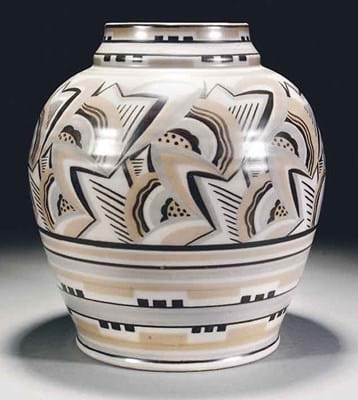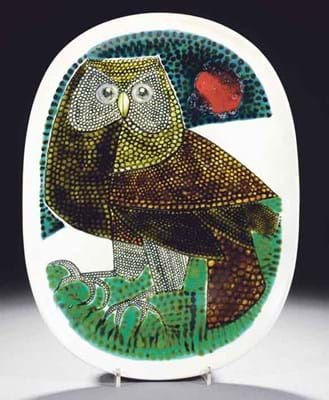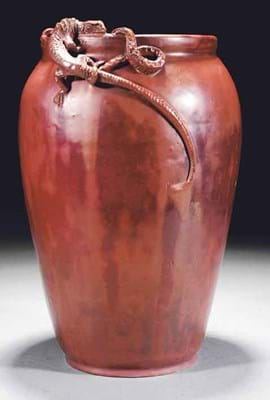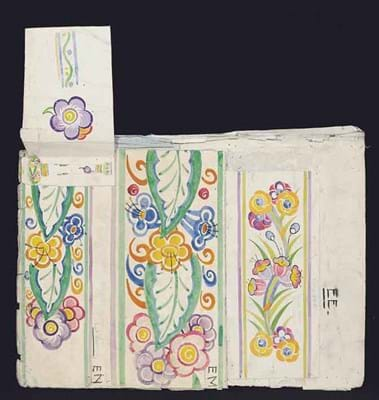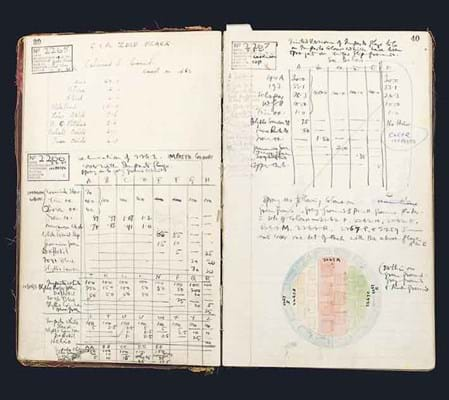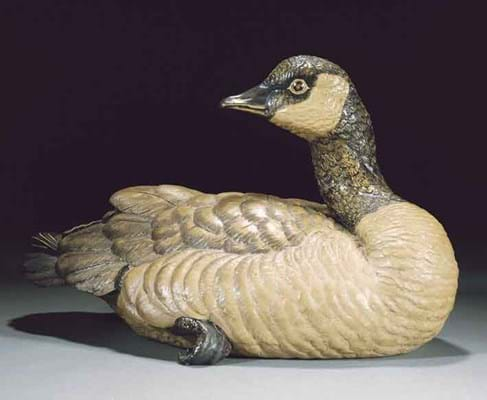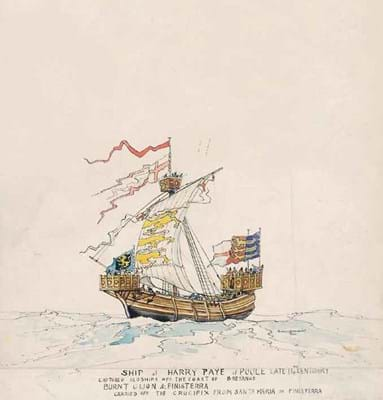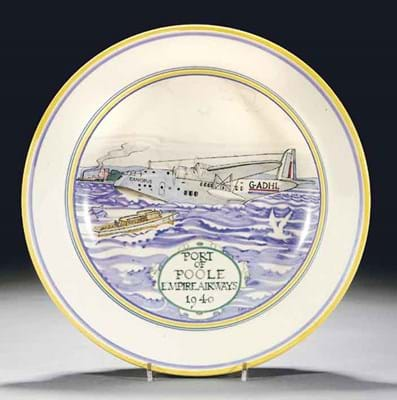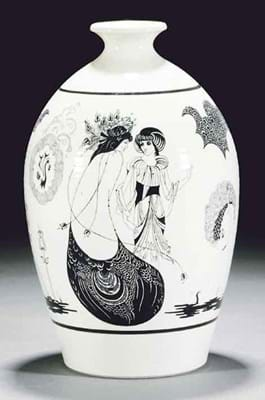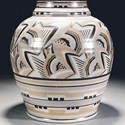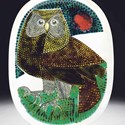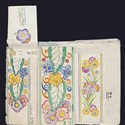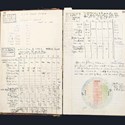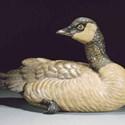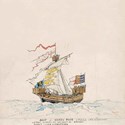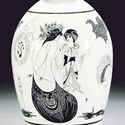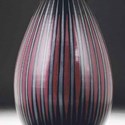They may offer material of great attraction and provenance, but they also represent the end of a slice of industrial heritage. Accordingly, there were mixed feelings about the arrival at the rostrum last month of several hundred pieces of pottery, pattern books, designs, photographs and other documentary material from the Poole Pottery's archive and museum.
Here was a rich selection including many mouth-watering pieces that Poole collectors would give their eye teeth to own.
On the other hand, the fact that the material on offer was being sold by administrators Leonard Curtis and Co to pay creditors of the pottery's previous owners, who went into administration last year, signalled the end of an era when these pieces were in the ownership and use of the pottery that produced them.
Fortunately the pottery itself has found a new owner in Peter Ford, so this distinctive Dorset product that has been one of the more adventurous elements of the British ceramics scene for well over a century has not disappeared for good. But when Mr Ford bought the pottery late last year he did not acquire its museum collection or its archive, leaving the administrators with the legal requirement to sell it to pay creditors.
Poole Borough Council made an attempt to buy the archive and collection outright last July (an undertaking that would have been contingent on grants and funding), but no successful agreement was reached with the administrators. The result was that, the collection went to auction at Christie's South Kensington (19.5/12% buyer's premium) on March 31.
Amidst a public outcry, a rescue attempt was made. What finally transpired was that the auction went ahead but the Borough of Poole were able to go to the sale armed with a spending pot of over £100,000 raised from various donations and grants with a view to securing as much relevant material as possible for the town.
This is not a unique situation. In many ways the Poole auction was similar to the dispersal of the Minton Museum at Bonhams two years ago by parent company Royal Doulton. But one significant difference between the two auctions was the factory archive.
While Minton's pattern books and original artwork were not included in Bonhams' sale, CSK's Poole auction featured a large slice of documentary material key to any history of the factory. By all logic this merited an institutional purchase, and it was a cornerstone of Poole borough's purchasing plan.
A five-man committee set up to coordinate the borough's initiative had earmarked a shopping list of 100 items. As committee member Alan Barlow, who was Poole Borough Council policy director until his retirement at the end of March, explained, they adopted what he described as "an ABC approach" to purchasing. On the A list were what he termed "all the items closely associated with the pottery". This was largely archival material plus a couple of major production pieces like a large tile panel map of Poole - "that was our number one piece".
The B list comprised "the more important pieces that would describe the way the pottery changed over the years". These would be key production pieces that would complement those already in the town's Waterfront Museum where any new acquisitions would be displayed. The C list comprised other pieces that the borough might want.
Eager competition
A team of three went Christie's to buy for the borough. Sue Beckett, the council's collections officer for museums, was there to do the bidding and Alan Barlow to do the spending calculations. In attendance was advisor Leslie Hayward, co-author of the standard book on Poole Pottery and a local Poole specialist.
But when the trio sat down in Christie's hangar saleroom on what was the sunniest day of the year to date, they faced formidable opposition. The auctioneers' large glass-roofed saleroom was packed wall-to-wall with eager-looking faces, some of whom were spilling outside the doors. While some of that audience may have been interested onlookers and others were specialist dealers, the vast majority were private collectors looking to buy a piece of the pottery's history. A sizeable number, reckoned Christie's specialist Joy McCall, were first-time buyers.
Christie's had divided the archive into 290 lots catalogued on a chronological basis, starting with Carter and Co's lustre wares produced at the turn of the last century and ending with trial plates produced in 2002. Estimates in virtually all instances had been set at very cautious levels.
"We deliberately priced the lower ranges low," said Ms McCall, while even the other rarer offerings were realistically pitched. This was largely to entice people to buy because, given the sale's circumstances, the administrators would not want to end up with unsolds back on their plate. Nor did they.
With just six lots unsold and a final total that at £212,700 was comfortably over predictions, the vendors will be very pleased with the outcome. There were no fewer than 114 different successful bidders by the end of the day.
But despite the wide spread of buyers, Poole Borough Council went much of the way towards achieving their goal. They carried off 72 of their 100 earmarked lots (66 at auction, the remainder as after sales) making them by far the biggest buyer at the sale. And crucially of the 26 lots in the archive section the borough were able to purchase around three quarters.
Sums on or around the estimate were the norm but the borough had to fight to secure Arthur Bradbury's drawing for the 14th centuryShip of Harry Paye (£1700) and lost the contest for Edward Bawden's ink sketch of Poole that served as the original source for the Poole map tile panel. The council wanted this to go with their number one target, but it took £2600 (estimate £300-500) from another buyer. "We were sad that we lost that," said Alan Barlow. Fortunately the borough had more luck with the panel itself, securing it for £13,000, just over top estimate. There was relatively little competition for this major piece and Alan Barlow said after the sale that he thought they might have had to go higher.
This wasn't the case with many of the other key or iconic pottery entries. A large 1930s vase decorated by Truda Carter in shades of brown and cream, with a striking abstract design, was a classic piece of Poole Deco and competition from the room forced the borough up to a double-estimate £6500 for this.
Yet more expensive was the early 1960s oval Studio ware dish designed and decorated by Robert Jefferson with a study of an owl. This had been estimated at £600-800, but with bidding opening at £1000 it was plainly going to leave that level far behind. The borough finally managed to secure it after much competition at £7500.
Even when the borough weren't bidding, there were some areas of the sale that saw more competition than others. Those pieces that are still relatively easy to find on the open market went as predicted. Noticeably more popular were anything to do with ships; the scarce group of black painted trial pieces inspired by Aubrey Beardsley designs; early lustre wares and some of the 'Sixties and 'Seventies pieces. Fashion, scarcity and historical interest variously determined demand for these.
Poole Borough Council's purchases are now at the Waterfront Museum and it was hoped that some of them would be on display by Easter. The archival material will be stored at Dorset County Council Records Office, who contributed £7500 towards the purchasing funds.

